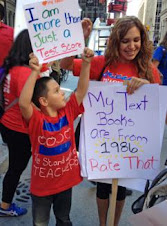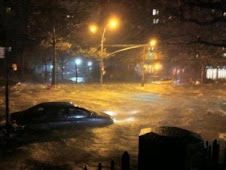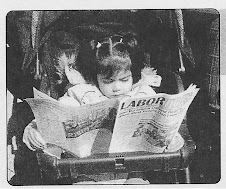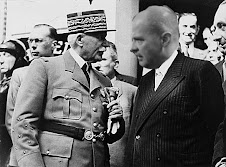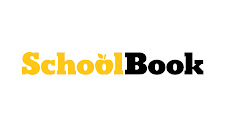Bloomberg and schools chancellor Joel Klein have moved schools to a far more segregated pattern than existed prior to Bloomberg's replacing of the last Board of Education-selected chancellor, Harold Levy.
The racial concentration (90 percent white schools, 90 percent black schools, 90 percent Latino schools) has been obvious to teachers in the schools. Just go to the schools report card portal. You can see the pattern of which races have been enrolled in the schools in the last decade.
This article is a rare gem. The iron hand of administrators very aggressively does not permit teachers to ever to speak to the press. As to reader complaints about the journalist and reporting procedures, these are red herring distractions. The basic issue: opponents of the journalist and his story are embarrassed that in this nice liberal city that elected an African-American president, there are some parents that are conveniently shutting their eyes to a blatant racial bias that they benefit from. How shameful that we put such emphasis on the Supreme Court's 1954 "Brown versus Board of Education of Topeka" decision, yet in our nation's largest city, the mayor has been able to avoid scrutiny and create heavily racially imbalanced schools.
The difference in resources between the two public schools in the same Upper East Side building demonstrates that the situation is separate and not equal.
A journalist's comment on the Village Voice site puts it best:
he teachers that used to work at Lab spelled it out clearly--a divide exists and its unfair and there is something that can be done about it. This should be a wake up call. By making subtle threats--(the Village Voice's corporate headquarters out West)--you're really illustrating the kind of behavior that this article lays out clearly. You will bully your way into getting what you want--whether it's a segregated school or a journalist to shut up.
Here, in its entirety is Steven Thrasher's article on P.S. 198, where the mainly black and Latino student body enters through the rear door, and P.S. 77 for the "gifted and talented", where the largely (69.3 percent) white student body enters through the front door:
Inside a Divided Upper East Side Public School: Whites in the front door, blacks in the back door
If you're a white student and you arrive at the public elementary school building on 95th Street and Third Avenue, you'll probably walk through the front door. If you're a black student, you'll probably come in through the back.
It's a very New York kind of school facility: two completely different elementary schools sharing the same space.
The boxy, utilitarian structure was built in 1959 to house P.S.198, named after Isador and Ida Straus to commemorate the Congressman and Macy's department store owner and his wife, who both died in the 1912 sinking of the Titanic.
Since 1988, the building has shared space with another school, in a tradition that has rapidly increased under the reformist scheme of Mayor Mike Bloomberg.
In this case, it's the Lower Laboratory School for Gifted Education (P.S.77) that has been given space in the old Straus building—including the part that contains the front door.
Lower Lab is mostly composed of white students (69 percent) and Asian children, who are driven in from all over Manhattan.
Straus is zoned, which means it has to serve any child from the local neighborhood. For that reason, it's overwhelmingly Latino (47 percent) and black (24 percent).
Over the main entrance, the old sign for Straus remains, but Straus kids are told to go around to the back of the building.
Even Straus staff members are instructed by the NYPD School Safety Agent at the front door to use the rear entrance.
An African-American attorney, Granville Leo Stevens, who showed up at the front door recently on official Straus business, says he was only "grudgingly" allowed to enter the front door after he complained to the SS agent.
"It's the craziest thing I've ever seen," Stevens says.
The only people welcomed openly to the front entrance of the schoolhouse are very young kids with killer testing skills.
Lower Lab is designated as talented and gifted, and it's open throughout the Department of Education's District 2—which includes all of the Upper East Side and much of Manhattan south of Central Park—but only to youngsters who score high on tests given to them at four years of age.
In return for the high marks, the privileged kids of Lower Lab not only never have to sit in classes with the Straus children, they don't even have to mix with them on the way to school.
By 8 a.m., except for a few stragglers, the local kids walking on their way to Straus—some holding hands with parents—have all trudged up 95th Street, entered a gate, crossed a schoolyard, and disappeared into the back entrance of the building.
And that's when the other kids start showing up. Classes for Lower Lab start later—at 8:30—so at about 8 a.m., the automobiles start to arrive: Black Mercedes sedans, town cars, and taxis pull up to the curb at the front door, depositing white children onto the sidewalk. At one point, on a recent morning, there were so many black SUVs backed up that it looked like a head of state was stopping by before heading to the U.N.
Lower Lab parents often get out of their cars to walk their children the last few feet to the front door. Mom and Dad wear well-tailored jackets and suits. Several children's coats are adorned with lift tags, suggesting a weekend ski trip. And many of the Lower Lab kids arrive with musical instruments slung over their shoulders. (Lower Lab has an instrumental musical education program; Straus does not.)
Inside, the building is not divided neatly in half for the two schools. They share floors, and a Lower Lab classroom might sit right next to a Straus classroom.
There are areas that both schools share. In these spaces—hallways, for example—an emphasis has been placed on harmony: The hallways have been given names like "Respect Avenue," "Understanding Street," and "Unity Avenue."
Except for these nods to cooperation, you see signs of the division between the two schools everywhere. In a hallway, on a recent morning, there was a five-gallon water bottle for soliciting funds for Haiti disaster relief—but only from Straus people. A large bulletin board reads, "We are All Connected," and graphically connects pictures of all the teachers, assistants, and administrators—of just Lower Lab.
On a wall of "Golden Rule Avenue," there's a display of "position papers" written by a class of Straus fifth-graders. The illustrated title pages demonstrate how earnest 10-year-olds can be.
"Eat Healthy! It's good for you."
"The Damaging Effects of Alcohol."
Another, "No Smoking!," features the declaration that smoking "Damages teeth! Damages chin! [Makes a] Hole in throat! [Makes you] Lose fingers!" It's accompanied by matching drawings of finger amputation, face mutilation, and even a tracheotomy—the horrors of each rendered for maximum effect in the hand of a child using Magic Marker.
If only these earnest young moralizers were so passionate about classroom order.
"They are good children, they really are," a fifth-grade Straus teacher says as she fights a continuing battle to keep things under control. "But I have to get them to listen," she adds, her voice rising as she turns back toward her chattering flock, giving them the evil eye.
Throughout Straus, the biggest challenge of having almost 30 kids in a room seems to be controlling the chaos. Over a 40-minute period, a science teacher was observed asking her children more than 30 times to quiet down as she tried to teach a lesson about earthquakes. She scolded them and gave them disapproving looks. The students responded by staring at the floor, looking ashamed (or at least pretending to be).
Seconds later, some students tuned out the earthquake lesson and began a discussion of Nintendo DS.
The modern elementary school classroom doesn't really seem to help the situation. Gone are the rows of individual desks of yesteryear. Today's classrooms look more like the kindergartens of the past, with children sitting on carpeting or together at large tables. It's all very conducive to chatty conversation and not paying attention. The students of Straus spend nearly the entire day in groups on the floor or huddled together at tables with friends.
In this particular class, most of the students are Latino and black, and a few are recent arrivals from China. There's one white kid—and she seems utterly oblivious of her minority status.
The teacher is a stern woman whose commute can last up to two hours each way. Teaching is her second career, and she obviously has a love for it.
In the middle of a lesson, her students' chatter gets too loud. She stops speaking, and turns off the lights. First, she admonishes "those of you who don't want to learn, who are holding others back." Then she calls out another equally disruptive group: "For those of you who think you're all that, may I remind you that you still have something to learn."
In the constant battle, the teacher is always fighting on two fronts: There are those who talk because they're poor students and can't sit still in a classroom, and then there are those who interrupt because they're smart and bored.
One student from the latter group—we'll call her "Doreen"—can be as distracting as one of the troublemakers. Her intelligence shines above her peers. While her classmates are gradually starting to read simple chapter books by authors like Beverly Cleary, she's already plowing through the Twilight trilogy.
But for all her intelligence, Doreen is as likely as anyone else to disrupt the class: She's quick to get bored, and she's not especially modest about being the best. When the teacher calls out "those of you who think you're all that," her tablemate—we'll call her "Gwen"—rolls her eyes and looks at Doreen.
"She's talking about you," says Gwen.
Doreen sighs. "I think I'm all that, because I am."
"Well, why do you have to brag about it?"
"Because I am the best."
"Yeah, but if I got a 100 on a math test and you got a 90, I wouldn't act like all that and make you feel bad."
"But I got the 100, and you got the 90," Doreen sighs. "She never gets a 100," she says in an aside about Gwen.
"So? It doesn't mean you have to brag about it!"
"But I do have to brag. I have a big ego."
"Be quiet, ladies!," the teacher yells, the lesson interrupted yet again.
The teacher desperately wants the Doreens of the class to do well: She is noticeably tougher on the bright kids who she knows have the intelligence but lack the discipline they'll need in the higher grades.
As a Latina in the New York City school system, Doreen's odds of finishing high school are about 50 percent. The chances that Doreen will get into a top public high school are low. Latino students make up almost 40 percent of the school system, but at premier city high schools, they are pretty rare: 8.2 percent at Brooklyn Tech, 7.7 percent at Bronx Science, 2.8 percent at Stuyvesant.
Most of the Latino children who will go to these top schools are already enrolled in talented and gifted schools—not schools like Straus. The odds are greater that a bright girl like Doreen will drop out of high school than make it to college.
Meanwhile, the odds are very different at Lower Lab. At the very least, Lower Lab kids will usually go to the NYC Lab School for Collaborative Studies. Many, whose parents paid hundreds or thousands of dollars in tutoring fees for their kindergarten entrance exam, will benefit from similar training to get them into even more prestigious high schools.
It's hard to get to know Lower Lab too well: Administrators don't make it very easy even for parents of prospective pupils to observe the school. The process of getting one of the coveted 56 seats begins in October each year, a full 11 months before the first day of class.
Even a tour can't be had until you've aced the kindergarten entrance exam. According to Lower Lab's website, only 200 tours are given a year, and "qualifying families will be asked to present a qualifying letter during the tour. We kindly request that families who did not qualify for our Kindergarten or First Grade T[alented] and G[ifted] program refrain from requesting a tour as space is limited." The site refers to pre-K and kindergarten classes that don't require testing as "Non-Talented and Gifted Programs."
And in case you get any ideas that Mom and Dad might want to decide together on whether or not Lower Lab is the right fit, forget it: "Tours will be available to only one parent or guardian per qualifying family."
(School officials were just as uncooperative with Voice requests for visits, interviews, or even e-mailed responses to questions.)
From a distance, at least, it appears as if, despite being under the same roof as Straus, the children of Lower Lab are living in a completely different world. It's not just that they show up in fancy cars and wear better clothes. Nor is it even that the equipment seems newer in their classrooms, and that the science lab makes Straus's look barren by comparison. (It does.)
But, as one teacher put it, you can see the message taking hold that the children are already receiving about their station in life: "These children are babies—they're four years old—when we start separating them! When you tell them from such a young age, 'You are more than, and you are less than,'—when you tell them 'You are gifted,' and 'You are not,' they get the message."
To hear the staff of Straus tell it, the teachers of Lower Lab—who have exclusive use of the front door—have gotten the message that they're special, too.
"Some of those teachers, they think that because their children are 'gifted,' that makes them better teachers," says one teacher at Straus. "But why? They've already selected out the highest-achieving kids. They're easy to teach. We have to take anyone who walks in. We have to bring kids to the table."
Teachers at Lower Lab also deal with children sitting in groups, who are no doubt just as tempted to slip into conversations. But the teachers in Lower Lab have a major advantage: They have an adult-to-student ratio half that of Straus's.
It's very noticeable when there's an aide or reading specialist present in a Straus class: The teacher has a much easier time keeping kids quiet than when he or she is on their own.
Being alone is never a problem for teachers in Lower Lab. Each has a full-time teaching assistant in the room. That's twice as much help with students who tend to bring fewer problems to the classroom to begin with. Lower Lab teachers don't have to deal so much with children who live in poverty (9 percent of Lower Lab children receive free or reduced lunch, compared to 73 percent of Straus). The rate of special education is lower (13 percent of Lower Lab to 19 percent of Straus). Even the English language isn't an issue for Lower Lab: Straus has 45 English language learners. Lower Lab? Zero.
And yet all Lower Lab classrooms are staffed with a full-time assistant teacher, paid for by a robust and powerful PTA.
The differences between the PTAs of Straus and Lower Lab may be the most stark of all.
The Straus PTA is described as "almost nonexistent," "not much to talk about," and "well-meaning, but not very powerful" by several people. One parent (incorrectly) thought Straus didn't even have a PTA.
The idea of a fundraiser for the Straus PTA is a bake sale (selling Baked Lays and other "healthy" snacks, that is). Meanwhile, Lower Lab's idea of a fundraiser is an auction. In the 2006–2007 school year, the annual auction brought in $166,289. That same year (the last for which public records are available), the Lower Lab PTA took in more than a quarter of a million dollars, and reported $424,868 in total assets.
The organization also encourages each family to donate at least $950 a year to their child's public education via a direct appeal.
It's African-American History Month, and the Straus fifth-graders are marching up "Understanding Street" to the combination library and computer lab.
Both schools maintain their own labs. Straus's isn't bad at all, and seems well-supplied with flat-screen Macs—it's questionable how much the children retain, though, as each class gets only an hour a week of computer time.
Students find a list of famous black Americans on each Mac. The teacher tells them to pick one to write an essay about, with a few caveats: "No athletes, and no entertainers."
"I know!" one child exclaims. "I'm going to do Martin Luther King!"
"And no Martin Luther King," the teacher says.
"Awww," goes the chorus. "But I already know about him!"
"Exactly," she says. "Time to learn about someone new."
"What about Jay-Z?"
"Is he an entertainer?" the teacher asks so sternly that the normally talkative child doesn't respond.
"Mohammed Ali?" another child asks.
"What did he do?" the exasperated teacher asks.
"He was a—boxer, it says."
"Is that a sport?"
"Oh, yeah."
The teacher moves around the room, trying to help the students pick a subject and begin their research. One child is told he can't write about President Obama, because they've already learned too much about him, too. A lazy boy picks bell hooks. He's surprised to discover that she's a woman, let alone a feminist scholar: "I don't care. Her name starts with 'B,' and I don't want to scroll down anymore," he says, looking at the alphabetized list. "The teacher said we can't do anyone cool. This sucks."
Doreen, hearing about the prohibition on athletes or entertainers, types "boring African-Americans" into Google to find a subject.
The rebellious kids are not the ones that most worry the teacher and the librarian. It's the 10-year-olds who seem to know absolutely nothing about a computer, and are more than halfway through their fifth-grade year. One student can't find the period on her keyboard; another child doesn't know how to use a Web browser.
"How many of you have a computer at home?" the librarian asks. About a third don't raise their hands.
Getting their hands on keyboards for only an hour a week makes it hard for the teacher to make the students master and retain their "prior knowledge," a phrase the teachers in Straus repeatedly use. Teachers seem confident about teaching their kids—getting them to retain and build upon it is another story.
Doreen's search for "boring African-Americans" hasn't yielded too many results. She has gotten it into her mind that she wants to research "that doctor who separated the conjoined twins." She thinks he's male, so she puts "African-American male" into Google, which generates banner ads that the 10-year-old girl probably shouldn't be looking at. (She finally discovers she's seeking Dr. Ben Carson.)
The part-time aide that sometimes helps out is with another class right now. Working in tandem, it's hard for the teacher and the librarian—by themselves—to attend to all of these kids, help each one individually, and prevent them from ending up on the wrong websites. They barely have time to help the children navigate the computers, let alone deal with the content of what they are actually supposed to be researching and writing.
Even the ones with computers at home, the staff knows, are more apt to play games on them than practice their word processing skills. And, come next week, they'll be starting from scratch again with some of the kids, as if this week's computer lesson never happened.
It's 6:30 p.m. in the school cafeteria, and the Lower Lab PTA is about to come to order. Except for one parent, everyone is white. Before the meeting begins, member Patrick Sullivan regales the people assembled with tales of his evening the night before.
Sullivan is Manhattan Borough President Scott Stringer's appointee to the Panel for Education Policy. The PEP, made up of five members appointed by the Borough Presidents and eight by Mayor Bloomberg, is the governing body of the Department of Education. Sullivan casts one of just 13 votes that control the entire school system of 1.1 million children.
The night before, the PEP had voted to close 19 struggling high schools. Each will be replaced with multiple schools, creating shared campuses like the one Straus and Lower Lab occupy. The vote came after a marathon nine-hour hearing, marked by racial tension.
Sullivan came off as the folk hero of the night. He stood up for the NAACP when testimony was cut off, to great applause from the crowd. He was one of the five dissenting votes against shutting down the schools.
In an interview with the Voice, Sullivan says that he was sympathetic to many of the protests that the mostly black and Latino parents were waging at the PEP about unequal treatment. But when asked about the inequities between the two schools in the building where his own children are students—where he is on the PTA—he didn't seem to view inequality the same way.
Does he think, for example, that there is a negative effect from having two racially segregated schools under the same roof?
"No, I don't think it has an effect," he says.
"[Lower Lab] is a gifted and talented program, and [Straus] isn't," he adds, more at ease talking about the issue in terms of economics than race. "The gifted and talented criteria is a standardized test that, I believe—and I believe many other people believe—unfairly draws from higher-income children and families, because they are better able to prepare for that test."
Sullivan says that he opposes the standardization of test scores for children citywide: "It used to be that the [talented and gifted schools] had different entrance criteria in different parts of the city, which would reflect the economics of the various zones." When the PEP voted to standardize scores, "I opposed it, and I was the only one who voted against it."
In Lower Lab's case, the sifting done by tests has resulted in a black population of just 3.1 percent.
If Sullivan was uncomfortable talking specifically about the racial differences between the two schools sharing a building, many black parents were not—even though they preferred to do it anonymously.
"We know they get better stuff and more money in Lower Lab," said one Straus African-American mother who works as a teaching assistant in a nearby school, "but there's nothing we can do about it." Another black parent, whose child was zoned for Straus, sent her to another school "so she wouldn't be humiliated by having [Lower Lab] in her face."
"Isn't that something?" the parent said. "I can't believe they put up with walking in through the back door."
Reconciling the disparity between what the schools receive is especially hard for the mother of one of the few African-American students who recently graduated from Lower Lab. "For my son and his development, I would have liked to have seen more students who looked like him."
When asked if she felt uncomfortable knowing her son received superior resources to most of the black students in the building, her gratitude outweighed her discomfort: "If I was on the outside, I'd say that that's not fair. But getting to be in the school, with my son there, I was happy to be the beneficiary of those benefits."
She candidly revealed that Lower Lab was a very good bargain for their money: "When you have 28 kids in a class, and you can give $500 or $950 a year, and you can have another teacher in the classroom and cut the ratio in half—I was happy to do it."
One thing that did seem to unsettle her, though, is her feeling that it happened through strong-arming. "The PTA was able to hire more personnel [teaching assistants]. That's circumventing Board of Ed rules. And in the Board of Ed, they are aware of this. But because the people on our PTA are powerful people, they are able to go out there and get these funds, and got what they wanted."
Another black parent put it more bluntly: "They've set up a private school within a public building, where they can raise money for their own kids, and their kids only."
It's the 99th school day of the year, and there is much to celebrate in the fifth-grade class of Isador and Ida Straus.
Not only is it the Friday before winter recess, but the class is having a lunchtime party (technically, a "cultural celebration"). The teacher has set up an elaborate chafing-dish buffet. Together with some of the children's parents, she has prepared a smorgasbord of foods to celebrate a smorgasbord of causes, including birthdays, Valentine's Day, the Chinese New Year, African-American History Month, and the final day of school.
Once the food is set and warming up, she returns to the carpet, where the children have been reading aloud When Marian Sang, a book about Marian Anderson.
"You see, children?" says the teacher, after Anderson has defeated Jim Crow to become an opera singer. "Marian experienced hardships, but she got over them. Every group has gone through hardships, and has gotten over them—black people, Latinos, Jews, Asians."
"Even white people?" one child asks his neighbor.
The food is served, and a table full of boys begins digging in. "This food is off the shizzle!" proclaims a bespectacled African-American boy. He and one of his best friends, a South Asian kid with a winning smile, are actually free to talk without being shushed for a change. They're arguing over who is taller, and whether or not hair should count in height. (The boy with the trim Afro thinks it shouldn't; the boy with the voluminous poof thinks it should.)
At the next table, a group of girls tries to trick adults in the room into revealing their ages by asking them what Chinese sign they were born under, then looking it up on the zodiac.
It's a festive mood, even though all the adults in the building cannot wait for 2:20 to arrive and their vacation to begin. With a snow day earlier in the week, the children have been unable to go out on the playground ever since, and they're wound especially tightly.
Despite the teacher's ebullience about the coming vacation—she is literally dancing at the thought—the hard work and money it has taken to put on this party shows how much she loves these children. She paid for the chafing dishes, and the food she has prepared out of her own pocket. Like all New York City teachers, she works with a budget of $150 a year—about 83 cents a day—to provide for all the supplies she'll need.
Unlike her colleagues at the other school in the building, there will be no reimbursement from the PTA. No auction is going to provide her with extra books, or a music teacher, or an assistant. Anything extra—like the food she cooked, after teaching all day and commuting four hours—is on her dime.
Once all of the children have been fed, there is still plenty of food. The teacher invites lots of other people to come in. Staff members and other teachers come on by. It seems like everyone is passing through.
Everyone, that is, except people from the other school in the same building.
The schools' PTAs exist on different orders of magnitude: Their teachers don't seem to interact at all. But what about the kids of the two schools? How do they interact with each other? Though they enter through separate doors, do they play on the playground? Can the "talented" and "non-talented" get along during recess?
The truth is, it never comes up, because they never, ever play together.
From arriving at different times, to having separate lunch times in the cafeteria, to having different recesses in the yard, the two schools just don't interact. They co-exist, as one parent put it, "like oil and water."
Dr. Pedro Noguera, a professor of education at NYU's Steinhardt school, and the author of The Trouble With Black Boys: And Other Reflections on Race, Equity and the Future of Public Education, thinks it's problematic to be segregating kids from such a young age: "When you send young kids to school where the racial lines are so stark, there is the process of saying there is something fundamentally different about us, which is why we can't be together.
"Some towns, because they are homogenous, their inability to create integrated schools is limited, simply by the fact that there is nobody else there," he says. "That's not the case in New York City. What we have here is really Plessy at work: separate, without even being equal—but very much separate."
In other parts of the country, cities and counties and states struggle with the inequalities that arise between schools that benefit or suffer from their geography—public schools in wealthy areas generally provide a better educational experience than public schools in poor areas. School districts have always wrestled with ways to minimize these differences, like how money is spent, how children are routed, and how teachers are allocated.
In New York, these striking differences have nothing to do with geography—not when two public schools can offer such unequal environments within the same building. And yet, the mayor's plan, embodied in the rush to close schools and replace them with even more multiple institutions, only seems to be exacerbating these differences.
Concerned about the lack of access for talented programs in Straus, the Department of Education is addressing the situation. Patrick Sullivan says the DOE will be starting a gifted program within Straus this fall, beginning with a kindergarten class.
Now, the zoned children will have the option of getting into a talented program, instead of competing with children district-wide. A girl like Doreen might have the chance to be in a gifted class, without competing against rich families who can pay for tutors. Teachers might not have to work as hard to accommodate their slowest and fastest students in the same class.
But the decision is not being universally heralded.
"Why on earth would [Straus] need to have a gifted class, if there's a gifted school already in the building?" asked one mother. "They say they're doing it to make the school more 'attractive,' but are they doing it just to keep [Lower Lab] segregated?"



